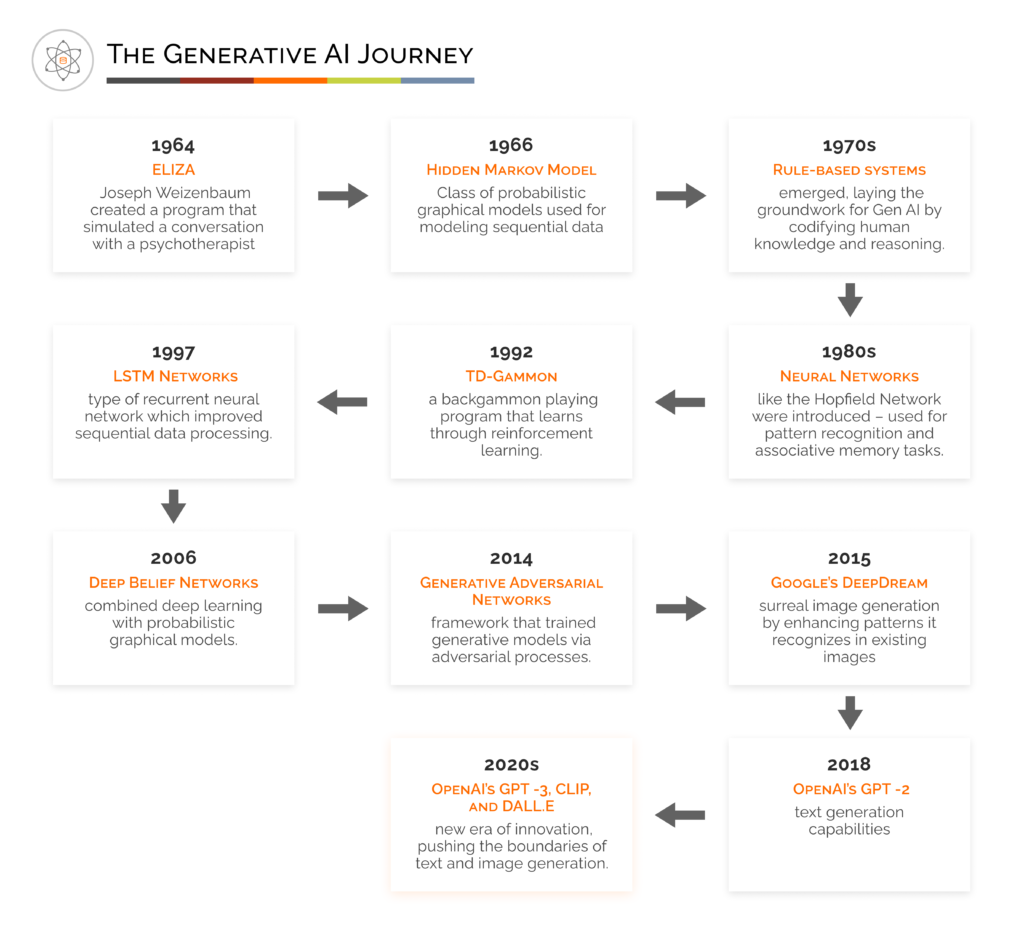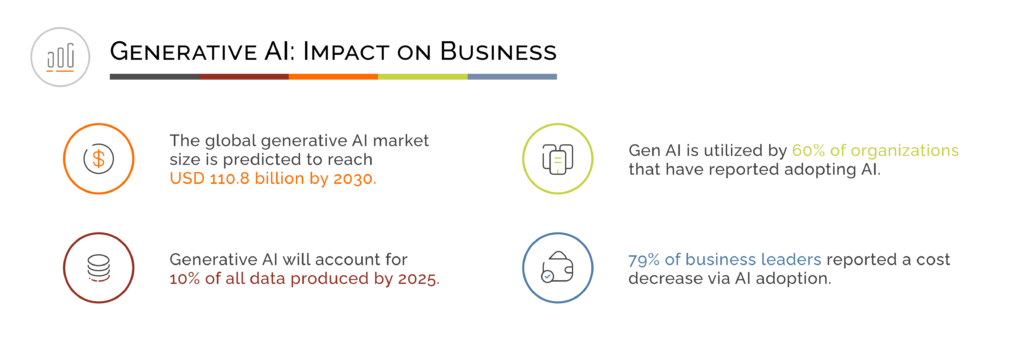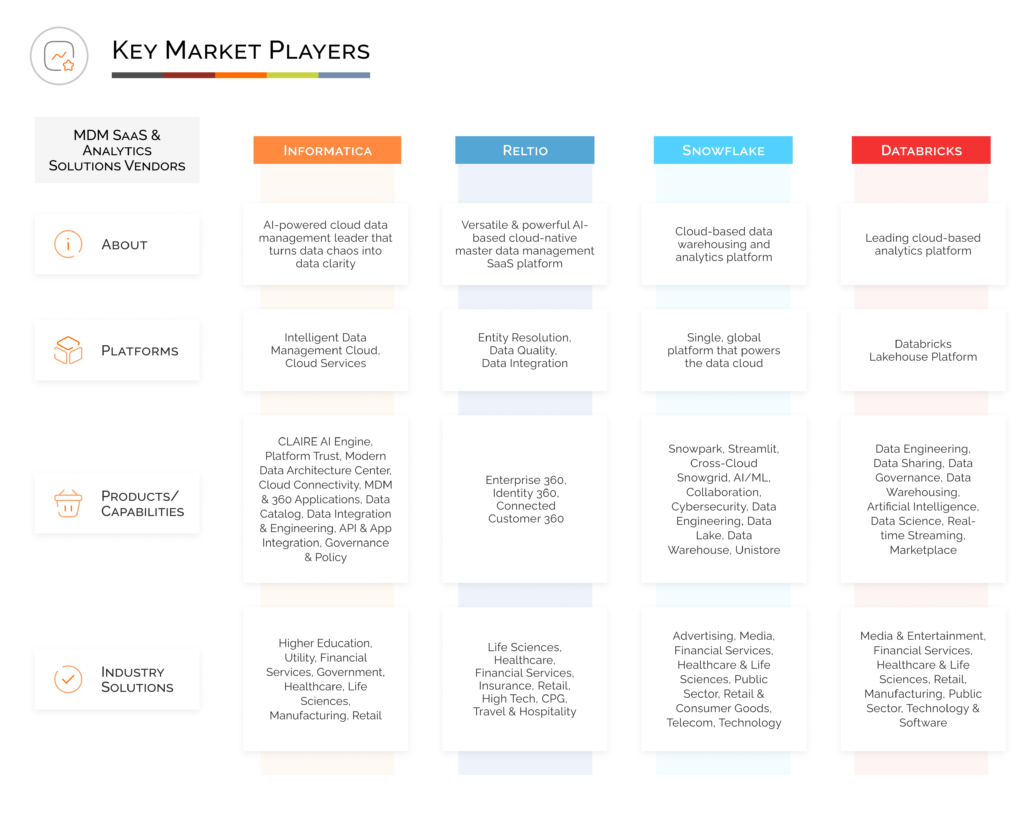Dive into the basics of generative AI. The blog will equip you with information on:
- Meaning of Generative AI and key statistics
- Generative AI for modern data management
- Application across diverse industries
- Cutting-edge MDM solutions powered by Gen AI
What is Generative AI?
Generative AI has taken the world by storm in recent years, transforming the way we create content, make art, or even conduct business. It is a branch of artificial intelligence focused on machines and algorithms that can generate content such as images, texts, music, and other forms of media.
As per Gartner, ‘Generative AI can learn from existing artifacts to generate new, artistic artifacts (at scale) that reflect the characteristics of the training data but don’t repeat it. It can produce a variety of novel content, such as, images, videos, music, speech, text, software codes, and product designs.’
Unlike traditional AI, which typically relies on predefined rules and data, generative AI uses techniques like neural networks to produce new data. You can find generative AI tools for various modalities. For instance, GPT and Jasper are text generation tools. DALL-E 2 is a popular example of image generation tool while GitHub Copilot is a code generation tool.
The Generative AI Journey
Generative AI has a rich history marked by significant milestones that have shaped its development. Here is a quick representation of some key moments in the evolution of generative AI.

Generative AI: Impact on Businesses
Generative AI’s ability to automate complex tasks has transformative implications. A significant 45% of the surveyed U.S. population uses generative AI. 67% of IT leaders have prioritized generative AI for their business while 33% consider it a top priority.

Here’s a quick take on how generative AI optimizes business workflows:
1. Greater productivity and efficiency
With generative AI, businesses can automate routine tasks such as data entry, document generation, and more. This frees up employees to focus on core business operations and growth. Moreover, generative AI helps create realistic simulations of various business scenarios that facilitates better risk assessment and strategy development.
2. Enhanced CX
Generative AI analyzes customer data and preferences to create personalized content such as product/service recommendations, tailored marketing campaigns, and customized product/service offerings. Moreover, AI powered chatbots and virtual assistants can provide instant and accurate responses to customer inquiries and assist with transactions, leading to quicker customer support. Also, NLP-powered AI can comprehend and interpret customer feedback, reviews to identify pain points and respond promptly to customer concerns.
3. Reduced operating costs
When business tasks are AI-driven, it eliminates the possibilities of manual errors, minimizing costly mistakes. Businesses can allocate resources more wisely. AI-powered predictive analytics and demand forecasting can optimize inventory management, reducing associated holding costs.
Industry-specific use cases
1 Healthcare
The process of developing a new drug – right from inception to being market-ready, is a complex process and might cost over $1 billion. Generative AI can help healthcare organizations accelerate such processes. It can also analyze patient data, including genetic information and medical history, to tailor treatment plans. Healthcare businesses can manage medical records better to extract relevant information from unstructured data and ensure data security and compliance.
2 Higher education
Educational entities can create personalized learning materials, adaptive curricula, and customized study plans tailored to student’s strengths and weaknesses. It promotes more effective learning. Moreover, it can streamline administrative tasks such as admissions and student support. Higher education institutions can easily predict enrollment trends and student performance.
3 Retail
Generative AI analyzes customer data to make personalized product recommendations and facilitate exceptional customer experiences. It can optimize inventory levels by predicting demand based on historical data and market trends. Moreover, generative AI can offer real-time product recommendations to customers as they browse online or in-store, increasing cross-selling and upselling opportunities.
4 Public sector
Generative AI can analyze large volumes of public data to identify the latest trends and patterns. Government agencies can leverage this information for evidence-based decision-making, policy formation, and program evaluation. Automated threat detection and prevention safeguards government data from cyberattacks.
5 Manufacturing
AI-based data analysis optimizes manufacturing processes. It helps identify bottlenecks easily, recommend process improvements, and adjust parameters in real-time to enhance product efficiency. Quality control is enhanced by identifying defects in real-time during manufacturing processes.
6 Financial sector
AI-driven models can assess credit risk and fraud detection with greater accuracy. Generative AI can simulate and predict various kinds of risk scenarios, allowing financial institutions to make more informed lending decisions and minimize potential losses. Customer data can be analyzed more accurately to provide personalized financial advice and investment recommendations.
Why leveraging generative AI for data management makes sense
Businesses are generating and collecting data at an evolving pace. Generative AI scales to handle complex datasets, making it a practical solution to tackle big data effectively. AI-powered tools and techniques can enhance various aspects of data handling, including data integration, data cleansing, data quality, data governance, and data analytics.
- It can easily identify data sources, create data mappings, and generate code for data extraction, transformation, and loading tasks.
- Generative AI can analyze datasets to rectify data quality issues, such as missing values, duplicates, and inconsistencies.
- It can create data lineage documentation and data classification rules, ensuring data compliance with regulatory requirements.
- Moreover, it can generate predictive models, reports, and visualizations from large datasets, enabling quicker and more accurate decision-making.
This is exactly why modern Master Data Management (MDM) solution vendors are incorporating generative AI into their offerings. Let’s learn how.
Cutting-edge solutions powered by Gen AI

a) Snowflake’s approach to Generative AI
Data search plays a pivotal role in reshaping how businesses access information. Snowflake is harnessing the potential of generative AI to revolutionize data exploration. Its recent acquisition of Neeva – a pioneering search company specializing in scalable and intelligent search solutions, is significant. The powerful duo helps users and application builders to facilitate search-enabled experiences within their data ecosystems. Non-technical users can access data more easily, enabling a broader range of individuals to extract actionable insights from their data without needing advanced technical skills.
Furthermore, Snowflake is taking steps to enhance its platform by integrating Large Language Model capabilities into it. Snowflake has introduced Document AI, currently in a private preview phase, which employs multi-modal LLMs. It helps users extract valuable information from unstructured data, such as documents.
b) Informatica’s innovative integration
Informatica has integrated generative AI capabilities, such as CLAIRE GPT, into its IDMC (Intelligent Data Management Cloud) solution to advance data management and analytics for customers. This transformative offering is expected to deliver up to 80% reduction in the time spent on critical data management tasks. It aims to empower data professionals by enhancing automation, compliance, and cloud migration processes.
c) Reltio’s data mastery with Gen AI
Reltio has augmented Entity Resolution capabilities powered by pre-trained AI models, making an-industry-first achievement. The Reltio Platform leverages AI/ML to help users accurately manage their core data domains, including customer, product, and supplier data. Data stewards can easily review and consolidate matches, resulting in high-quality data and enhanced data management.
d) AI development with Databricks
Databricks has introduced new generative AI tools and invested in Lakehouse AI. It enables customers to develop generative AI applications, including LLMs, directly within its Lakehouse platform. Lakehouse AI adopts a distinctive approach to AI and offers built-in capabilities across the entire AI lifecycle. Some of the new features include Vector Search – a curated set of open-source models, LLM-optimized Model Serving, and MLflow 2.5 featuring AI Gateway and Lakehouse Monitoring.
Wrapping up
LumenData stands as a trusted partner, collaborating with all the foremost cloud-based data solution vendors mentioned above. With this strong network of partnerships, we are well-positioned to assist businesses in harnessing the technologies and leveraging the capabilities of Generative AI. Start a conversation today.
Reference links:
- https://www.gartner.com/en/topics/generative-ai
- https://medium.com/data-science-at-microsoft/generative-ai-openai-and-chatgpt-what-are-they3c80397062c4
- https://www.salesforce.com/news/stories/generative-aistatistics/#:~:text=73%25%20of%20the%20Indian%20population,surveyed%20is%20using%20generative %20AI.
- https://www.acumenresearchandconsulting.com/generative-aimarket#:~:text=The%20Global%20Generative%20AI%20Market%20Size%20accounted%20for%20USD%2 07.9%20Billion%20in%202021%20and%20is%20projected%20to%20occupy%20a%20market%20size%20 of%20USD%20110.8%20Billion%20by%202030%20growing%20at%20a%20CAGR%20of%2034.3%25%20 from%202022%20to%202030.
- https://www.gartner.com/en/newsroom/press-releases/2021-10-18-gartner-identifies-the-top-strategictechnology-trends-for2022#:~:text=By%202025%2C%20Gartner%20expects%20generative%20AI%20to%20account%20for%2 010%25%20of%20all%20data%20produced%2C%20up%20from%20less%20than%201%25%20today.
- https://www.mckinsey.com/capabilities/quantumblack/our-insights/the-state-of-ai-in-2023-generativeais-breakout-year
- https://www.ncbi.nlm.nih.gov/pmc/articles/PMC3058157/#:~:text=Developing%20a%20new%20drug%2 0from,in%20excess%20of%20%241%20billion.
- https://www.snowflake.com/blog/generative-ai-llms-summit-2023/
- https://www.snowflake.com/trending/generative-ai
- https://www.informatica.com/in/about-us/news/news-releases/2023/05/20230509-informaticaexpands-its-intelligent-data-management-cloud-with-innovations-led-by-claire-gpt-industrys-firstgenerative-ai-powered-data-management-platform.html
- https://www.reltio.com/news-releases/reltio-expands-ai-ml-innovations-unveils-industry-first-pretrained-ml-model-for-automated-entity-resolution/
- https://www.databricks.com/company/newsroom/press-releases/databricks-introduces-newgenerative-ai-tools-investing-lakehouse
Authors:

Shalu Santvana
Content Crafter

Mohd Imran
Senior Consultant

Mohd Imran
Senior Consultant

Shalu Santvana
Content Crafter



